February 27, 2004
Air Date: February 27, 2004
FULL SHOW
SEGMENTS
Avian Madness
View the page for this story
Part One: Spring is the time of year when amateur birders emerge from their winter dens, binoculars in hand, to track their avian quarry. But for the competitive birder, all four seasons are fair game for finding rare bird species, especially if that birder is doing a Big Year. Host Steve Curwood talks with author Mark Obmascik about the most competitive year-round birding contest in North America, and his new book, "The Big Year: A Tale of Man, Nature, and Fowl Obsession."
Part Two: We continue our conversation about The North American Big Year, and talk with competitive birder Greg Miller, who made it to the top ranks of the 1998 Big Year, but not without a little luck, and a lot of credit card debt. (29:00)
Emerging Science Note/Microbial Fuel Cells
/ Cynthia GraberView the page for this story
Living on Earth’s Cynthia Graber reports that bacteria can clean waste water and generate electricity for a fuel cell - at the same time. (01:20)
GM No! Mendocino?
/ David JohnsView the page for this story
Organic wine growers in Mendocino County on the California coast are backing a Super Tuesday initiative to ban the cultivation of any genetically engineered plants in the county. They say a no-GMO label could be good for marketing. David Johns reports. (05:40)
Green Burials
/ Mitzi RapkinView the page for this story
Dying is big business in the United States. Some twenty billion dollars are spent annually on funerals and cemeteries. The past few years have seen an evolution in the funeral industry as individuals try to find creative ways to memorialize their loved ones. As Mitzi Rapkin reports from South Carolina, one man is offering burial services in an outdoor preserve that not only save money, but are ecologically sound, as well. (09:00)
This week's EarthEar selection
listen /
download
Show Credits and Funders
Show Transcript
HOST: Steve CurwoodGUESTS: Mark Obmascik, Greg MillerREPORTERS: Ingrid LobetNOTES: Cynthia Graber
[THEME MUSIC]
CURWOOD: From NPR - this is Living on Earth.
[THEME MUSIC UP AND UNDER]
CURWOOD: I’m Steve Curwood. Of the millions of birdwatchers in North America, only a select few go for the grand prize of birding: spotting the most species of birds in a single year. It’s mostly a competition for the rich, but one winner is famous for living on the edge as he hitched across America chasing his fowl obsession.
OBMASCIK: Most amazingly, he actually lived often on a can of cold Campbell’s soup, and he would pour Little Friskies Braised Liver cat food into it and chow down [laughter]. Just to see birds.
CURWOOD: These extreme birders may sound a little cuckoo, but their motives and their methods are most honorable.
MILLER: In birding, credibility is like virginity, you can only lose it once.
CURWOOD: The biggest feather in the birders’ cap - this week on Living on Earth. Stick around.
[NPR NEWSCAST]
ANNOUNCER: Support for Living on Earth Comes from the National Science Foundation and Stonyfield Farm.
Avian Madness
CURWOOD: From the Jennifer and Ted Stanley studios in Somerville, Massachusetts, welcome to Living on Earth. I’m Steve Curwood.
Step inside any sporting goods store, and chances are binoculars and birding guides aren’t the first items you’ll see on display. But as many in the birding circles would say, their hobby and, in some cases, their obsession, deserves a trophy spot in the sporting world. Especially, if you’re a birder who’s been through a Big Year.
Mark Obmascik is author of “The Big Year: A Tale of Man, Nature, and Fowl Obsession.” His book chronicles the race among three men to win the most competitive contest within the birding world: The North American Big Year. Mark, welcome!
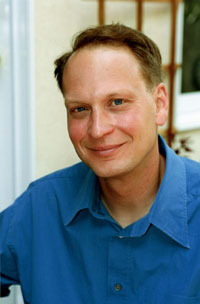 Mark Obmascik, author of “The Big Year.”
Mark Obmascik, author of “The Big Year.”
CURWOOD: Now, I understand that the results of the Big Year are published every year in the American Birding Association’s magazine and, as you write, it generates more gossip than an eighth grade locker room. What exactly is the Big Year?
OBMASCIK: Well, the Big Year is kind of the Super Bowl of birding – how many birds can you see north of the Mexican border in a year? And you can use pretty much any means to go see them. People go out by car, by truck, by helicopter, in some cases, mountain bike. And the idea is just to chase a rumor of a rare species anywhere on the continent.
CURWOOD: A rumor of a rare species?
OBMASCIK: With the information revolution, what’s happened is there are places in North America where, if a rare bird lands, it will be on the Internet within minutes. And there are literally hundreds, if not thousands, of people in the country who will chase it, just for a chance to add it to their life list.
CURWOOD: Now, before we get to the story of the three men that you follow throughout the 1998 Big Year, I want to talk about some other men who are among, I guess, probably the most elite, and certainly the most extreme of birders. I’m thinking of John James Audubon, Roger Tory Peterson, and Ken Kauffman. Tell me, how did Audubon and Roger Tory Peterson set the bar for the Big Year?
OBMASCIK: Well, there’s a great tradition of people being consumed by their obsession for birds. John James Audubon was a man who – a Frenchman who came to America to duck Napoleon’s draft. He got here and fell in love with these beautiful feathered creatures. He ran, I think, four or five businesses into the ground because he was so consumed with going into the woods and finding new species and painting them.
He ended up doing a grand tour of North America. Now, in his day, birds were sighted by the eyepiece of a gun. He, in many cases, shot dozens, if not hundreds of birds to be able to get the one that he wanted, to put it in the exact pose to be painted. But he ended up completing a wonderful project, “Birds of America,” in which he painted all the birds he could find in life-size poses.
CURWOOD: And how many birds is that?
OBMASCIK: Well, at the time I believe it was more than 400 birds.
CURWOOD: And Roger Tory Peterson?
OBMASCIK: Roger Tory Peterson is really the father of modern American birding. He went off on one of the great buddy trips of our time. This is way before “Thelma and Louise.” But he hooked up with the great British naturalist at the time, James Fisher. And they got a car and put a parabolic reflector on the top that would magnify bird calls. They started in Newfoundland and went down the coast, and just started looking for birds.
They found hundreds and hundreds of birds. It’s really – they wrote a book about it called “Wild America” which is this sweet time capsule of what life in America was like before the interstate highway system, before much development. They talk of driving through southern California, around Pasadena, and smelling nothing but orange blossoms.
So, Peterson, in this terrific book “Wild America,” ended up writing one tiny, little footnote, an asterisk at the bottom of a page which noted: “my year’s list, at the end of 1953, was 572 species.” Well, that was the footnote that launched the whole Big Year phenomenon. There were a lot of people who read that and said, I can match that. Or, even more – I can beat it.
CURWOOD: So they set out to do it. Now, you talk about a number of these people. I’ve got to say, the story of Ken Kauffman really fascinated me. Can you just briefly describe what Ken Kauffman did?
OBMASCIK: Sure. Ken Kauffman has kind of become the hero, in many ways, of the birding movement. He dropped out of high school at age 17, from Kansas, and decided to do a Big Year. He had no money. His father was unemployed. What he did is hitchhiked his way across America and Canada for a North American Big Year. He spent less than a thousand dollars total by thumbing his way across the country. He got beaten up in Nome, he was sleeping under viaducts. And, most amazingly, he actually lived, often, on a can of cold Campbell soup, and he would poor little Friskies Brazed Liver cat food into it, and chowed down.
CURWOOD: Cat food? Cat food!
OBMASCIK: Just to see birds. He had no money.
CURWOOD: I guess it takes a certain mentality, a personality, to succumb to the birding obsession. I know a little bit of it. I suspect my mother was maybe a bit of an obsessed birder herself. Because she used to make us get up at three in the morning, four in the morning – we’ve got to get into the car now! We’d drive out to this place, it would be freezing cold, probably wet -- and, I mean, what do you think? What kind of person is drawn to birding, and at what point does it turn, do you think, to obsession? As you call it “fowl obsession”?
OBMASCIK: It’s a slippery slope. Birding really can be addictive. One thing that amazed me when I started looking into this project was just the sheer number of people in this subculture.
There is a U.S. Fish and Wildlife Service report that says that there are roughly 40 million Americans who try to figure out what birds are in their backyard. Now, these are mostly feeder people. They’re the ones that have got all the sunflower husks on their lawn. Forty million people – that’s about one out of five so-called adults in the country.
But that’s not a measure of the obsession. There are 3.6 million people, or a population roughly the size of Connecticut, who can identify 40 or more species solely by sight or call. I mean, think about that. Forty or more species. Most people can look and say, well, there’s a pigeon, there’s a mallard, there’s an American robin. There’s three, keep going, you need 37 more.
That’s a lot of people, a population the size of Connecticut. But the obsession, here’s where the obsession kicks in -- there are actually 2.4 million people who keep a life list of every species they’ve ever seen. A life list. When you start writing stuff down, I think that’s where the addiction kicks in. That’s a birding army the size of Arkansas. That’s how many people keep a life list.
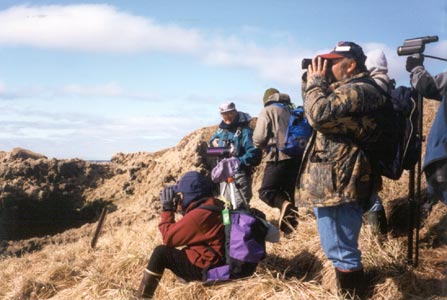 Birdwatching at the outpost of the Aleutian Islands, Alaska. (Photo: Barbara Davis)
Birdwatching at the outpost of the Aleutian Islands, Alaska. (Photo: Barbara Davis)
CURWOOD: Now, let’s see, Mark, I guess it’s fair to say that the three birders that you follow for the ’98 Big Year are obsessed with this. They’re obsessed with their quarry. But they’re very different, the three different men that I read about in your book with this one all-consuming goal. And I’m just wondering if you can give us a brief profile of each of them.
OBMASCIK: Sure. The first guy, the guy who originally sold me on the whole prospect, was a man named Sandy Komito, whom I first talked to – I found him through the American Birding Association. And I called him up, and he’s got this voice that starts about three floors below the basement. He’s from the Bronx, grew up dirt poor there, so poor that he only had one shirt that he had to wash every day by himself before he went to school.
And yet, he kind of scrapped and clawed his way to the top of one of the most macho businesses in the industrial northeast. He was an industrial contractor in New Jersey. And he started telling me about his business and roofing factories. And then he told me what he did for a year. He chased beautiful, fragile, delicate little birds. And I just thought, what a terrific contrast between the man’s man in a really tough business and a guy who’s consumed by his abiding passion for birds.
Now, the next contestant is a man called Al Levantin, who also grew up poor, penniless, but he also was fatherless. And his mother sent him away from his home in the Bronx to get contact with adults. She sent him to Boy Scout camp, which is where Al fell in love with birds.
Now Al, like many of these birders, never does anything half way. He went off on a career bender. He was working 60, 70, 80 hours a week, flying a hundred thousand miles a year in pursuit of his career. And he ended up being the CEO of a couple of companies and running a major international division for a Fortune 500 company. But he had 40 years of repressed obsession with birds.
When it came time for him to retire, his wife, who was a marriage counselor, had actually once calculated that in 37 years of marriage they had never once, not once, ever been together for 30 days in a row. So what happens when it comes time for the road warrior to retire again? He wants to do a Big Year.
Well, his wife, the marriage counselor, just thought, boy, if he’s got this passion, if he’s got this itch he need to scratch, then go do it. And Al did. He birded like a man possessed. But it’s sweet, because at the end what he found was that he really missed his wife.
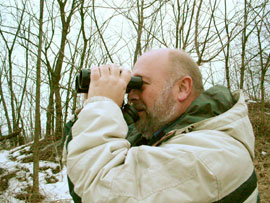 Birder Greg Miller (Photo: Ned Miller)
Birder Greg Miller (Photo: Ned Miller)
And the really sweet thing was, he every night would call his father and do strategy about a Big Year. His father was sick and not able to chase in the field as Greg was able to. And so he would say, “Dad, there’s a flamingo being seen in the Everglades. Should I use my cheaper advance tickets to go try to see the flamingo there? Or, oh no, there’s a Xantus’ hummingbird being seen in Gibsons, British Columbia. Should I take the more expensive flight to go out there?” So, little by little, they talked and built it back together. It was really sweet, as well.
CURWOOD: So how did you get hooked by birds? Because I have a sense that maybe once upon a time you were a good journalist, good reporter who didn’t know that much about birds, or maybe even care that much. And now, I suspect I’d find some binoculars out in your car.
OBMASCIK: These guys sucked me in, I confess. I started this project mainly as being interested in obsession as a fun and pretty interesting thing to write about. But you go in the field with them and their enthusiasm is just so contagious.
I remember the first time I was out in the field with Greg Miller, and we went to a field near his home and got out of the car and stood up – and he just starts calling out, “northern cardinal,” “lazuli bunting,” “house wren.” He hadn’t even lifted his binoculars. I thought he was playing a David Letterman trick on me.
But Greg, it turns out, had learned from his father to bird by ear. I mean, there are some people who know the first three chords of every Rolling Stones song and can identify them. Greg has an unbelievable ear and can identify virtually all of the homegrown bird species of North America. I mean, it’s really a remarkable skill.
CURWOOD: We’re talking with author Mark Obmascik about the greatest birding competition in history, the 1998 Big Year. We’ll hear more about the race to claim the most coveted birders prize, and we’ll talk with one birder who managed to claw his way to the top when we return. I’m Steve Curwood, and you’re listening to Living on Earth.
[MUSIC: Peter Gabriel "Shaking the Tree" SHAKING THE TREE: 16 GOLDEN GREATS (Universal Records - 2002)]
CURWOOD: Welcome back to Living on Earth, I’m Steve Curwood. We’ve been talking about one of the most competitive and curious contests in the sporting world -- the North American Big Year, where the top birders in the world vie for the distinction of spotting the most birds in North America in a single year.
Joining me now is Mark Obmascik, who has written a book about the greatest Big Year in history. And also joining us from WKSU in Canton, Ohio, is Greg Miller. He’s a birder who made it to the top ranks of the 1998 North American Big Year competition. Greg, congratulations and welcome.
MILLER: Thank you, hello.
CURWOOD: Now, throughout your Big Year you’re pretty much the underdog here with the competition. I mean, the other guys are I think, what, millionaires? And you have a nice job working in a nuclear power plant, but I don’t think it pays a million bucks a year --
MILLER: (laughs)
CURWOOD: So, when do think was your most difficult time in this competition?
MILLER: Probably the most difficult time was when I got back from Alaska in June. I’d traveled across from Minnesota -- halfway back from Alaska I’d stopped in Minneapolis, drove to Yellowstone and back in four days. And I got back home, I had seen over 600 species of birds by that time. I was out of money, out of vacation, and I was sick and just really worn out.
I had had my doubts about continuing on. I have a friend in southern Maryland, Kyle Rambo, who sat down with me at supper and I was sharing some of my stories about the Big Year. And he said, “Let me get this straight: You are over 600 species of birds, you’re halfway through the year, and you’re not even going to try for 700? When do you think you’re ever going to be here again?” And he had a point.
CURWOOD: So, you’re friend says go for it, and you –
MILLER: So I knew there was a slim chance, and I decided to go ahead and go for it. I went to my boss and told him, I said, I’m at 611 species of birds -- the old record at that time was the 1987 record, 721 – I’d like a shot at the North American record. He might not have understood birding but he understood records. So he said, well, let me know what you need, and as long as you’re on schedule with your work you can continue forward.
CURWOOD: Well Greg, I understand you have a pretty incredible ear for birdcalls. We’re going to put you to the test here if you don’t mind. Are you ready?
MILLER: Okay.
CURWOOD: So let’s play some calls now. If you could please play the first one…
[HOOT OF AN OWL, “WHOO”, “WHOO”]
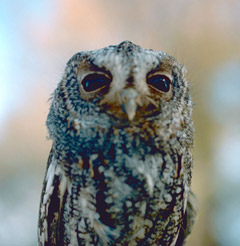 Flammulated owl (Photo: Gary M. Stolz/USFWS)
Flammulated owl (Photo: Gary M. Stolz/USFWS)
[“WHOO”]
CURWOOD: You didn’t even hear half the hoot before you answered!
MILLER: (laughs) Well, that’s one that I’ve listened to for a long time, and one that I had quite an experience with during my Big Year.
CURWOOD: Oh really? What happened?
MILLER: Well, I was with Stuart Healy in southeastern Arizona. We were in Cave Creek Canyon. It’s inside a national forest and you can’t use tape-recorded sound of a bird to attract it there, especially owls, because there’s a lot of birder traffic and they don’t want to disturb the owls.
It was after dark. We waited for about 45 minutes and had not heard the flammulated owl at all. And I had with me an empty Lipton Tea bottle, which I blew over the top of just as a last-resort thing, wondering if it would work. And I got a response out of the owl. Whether the owl thought it was an actual toot, or whether it was just frustrated or surprised to hear something like that, I don’t know. But it called and I was able to recognize its very unique individual toots.
CURWOOD: All right, we’re going to continue with our test now. Number two, please.
[CHOPPY BIRD CALL, LOUD, THEN QUIETING]
MILLER: Willow ptarmigan.
CURWOOD: Uh-huh…
MILLER: (laughs) To me this has one of the most comical calls of all the birds of North America. It sounds like somebody trying to make little sounds with their throat or the back of their throat. (laughs).
CURWOOD: Now, were you to find this bird, where do you think you could find it?
MILLER: You can find them easily in Alaska. Driving along the Denali Highway they’re like chickens crossing the road. They’re quite common up there.
CURWOOD: All right, now we have another one for you Greg. Are you ready?
MILLER: Ready.
CURWOOD: Here it comes.
[WHISTLING BIRD SONG]
MILLER: Colima warbler. It’s got a trill that kind of slows down toward the end, and then it has that very distinctive abrupt end.
CURWOOD: Now, I understand it was handy for you to know this call. Can you tell me the story?
MILLER: Sure. The only place that the Colima warbler occurs north of the Rio Grande is in Big Bend National Park. And within Big Bend National Park it’s in the Chisos Mountains. And it requires a full day hike, normally, to get up to Boot Spring, which is about seven miles distant one way and probably about 7,500 feet. So it’s a moderate hike even for a normal hiker, and for a birder it’s one of the most rugged of hikes.
But knowing the song really helped me, because I got up to about 6,500 feet at Laguna Meadow, which is only about halfway to Boot Spring. And I heard these birds calling, and I waited there and I saw three birds – three of the Colima warblers there – and it saved me a full day hike to Boot Spring. So I was able to turn around and go after other birds.
CURWOOD: As I read this book, I came to realize that during much of this year, Greg, you never met your birding rivals. And the other two men, in turn, didn’t even suspect that they were contending with you. But I guess the three of you finally do cross paths. And at one point in this story you even have dinner. How do you think this meeting affected each of your performances for the rest of the year?
MILLER: Well, the first time that we all three met during our Big Year was on October the 8th. We all individually, and independent of each other, chose a boat trip, Brian Patterson boat trip off of North Carolina, and hoped to find some odd species of birds. But when we all got together, of course you have the banter about the friendly competition, but you also respect the other person for all the traveling and hard work that you know that each of them put into it. Because it’s an amazing thing to put together the logistics, the travel, and the persistence to be able to see that many species of birds.
CURWOOD: You know, something that I find truly remarkable in this story is this code of honor, apparently, among you birders. And Mark you write about it in your book, and Greg, I guess you experienced this first hand during your Big Year. I’m thinking particularly of when Al Levantin -- the two of you are neck and neck in your count towards the end here, and he actually helps you track down a white tailed ptarmigan. I mean, this is a bird that Mark describes as one of the most lusted-after prizes in birding. Why do you think Al did it when it actually put you ahead of him in the contest?
MILLER: Al’s just a nice guy. And I did the same thing for Al, too. I helped him see a gray partridge up in Boise, Idaho, after our helicopter trip to see a Himalayan snow cock. Part of the reason was because we already knew that Sandy Komito was so far ahead of us that there was no way that either one of us individually was going to beat him. And we decided to help each other see as many birds as we could.
CURWOOD: Mark, I want to get your perspective on the code of conduct, that birders in intense competition with each other seem to want to reach out and help each other. What’s that all about?
OBMASCIK: One thing that amazed me about this story is that a Big Year becomes as much a question of honor and integrity as it does about winning. These guys did help each other out. And frankly, I can’t come up with another competition that’s like that.
I mean, these guys during their year, they had a million opportunities to cheat. They could have made stuff up left and right. And frankly, with these three guys, I could never find a single time when they had made something up.
In fact, one of these guys ended up telling me – Sandy Komito – in birding, credibility is like virginity, you can only lose it once. I asked Al Levantin the same question, and he said, what’s a Big Year for? There’s no prize, there’s no trip to Disney World. Why do you do it? If you cheat, who are you cheating?
And so I think these guys really were amazingly honest, amazingly careful. And you just think of everything you read these days about, say, CEOs in the paper – Al Levantin was a CEO. He helped out a competitor at the very end. These guys have solid lists, and it’s a pretty remarkable thing.
CURWOOD: Now, let’s talk a little about the unusual nature of 1998. This Big Year coincides with this huge El Niño event, this huge unusual weather event, so nature really plays a hand in increasing the birders’ counts here. Mark, I’m just wondering if you could explain to our listeners the concept of ‘fallout’?
OBMASCIK: Fallout. Well, migration is a pretty awesome natural phenomenon. What we expect birds to do every day, what we just take for granted, is really nothing short of remarkable.
Every night in April there are millions, tens of millions of birds that take off from the Yucatan. And in one night these creatures, some of them as small as your pinky – the little ruby-throated hummingbird, you can mail ten of them for the price of a single first-class postage stamp – they take off the Yucatan, their job is to fly across the entire Gulf of Mexico. Five hundred miles without stopping. If they stop they die.
And so they launch on these epic journeys above the waves. But sometimes what happens is they get confronted by a storm. And when a storm happens – I mean a bird is giving its all, it’s exhausting all of its fat reserves, and at certain points it can literally start to cannibalize itself. It begins to consume its own muscle tissue to try to hit land. And what happens at a place like High Island, Texas, between Houston and Beaumont, which is really nothing more than a big clump of trees along the coast, these birds will literally ‘fall out,’ or drop like a hailstone from the heavens.
The first sight of land that they have, these birds, which are just teetering on the edge of death, they just drop. And they hit these branches of the trees. And suddenly there are privet bushes that look like they’re adorned with Christmas ornaments. I mean, there are summer tanagers and warblers and cardinals. It’s a wonderful, beautiful, amazing sight. But these birds are spent. These birds have given it their all, and they’ve survived. And that’s just something we’ve come to expect these remarkable creatures to do.
CURWOOD: What’s that like Greg, when you come on a scene like that?
MILLER: Normal migration is pretty impressive itself, but when you get a fallout … A powerful front is not good for the birds, but it’s something every birder dreams about. Because what happens is, instead of maybe having hundreds of birds on the ground at eye level, you have thousands of birds all around you in bushes at eye level. You can reach out and literally touch them, they’re so close. And just the experience of seeing birds that close is just amazing.
CURWOOD: This is a difficult question to ask, but I’m going to try anyway. What kind of feeling of letdown do you have when you finally see a really prized quarry? I mean, you’ve spent so much effort to track it down, my golly. You’re renting helicopters and climbing mountains and enduring seasickness to see this little squab of feathers and squawk – and then it’s over.
MILLER: Actually, the elation and the euphoria of seeing a rare bird doesn’t go away as quickly as you might imagine. Because once you make a bunch of chases and you go across the continent and you’re chasing birds – some you see, some you miss – and it’s the misses that make you savor the ones you do get to see.
Because there’s nothing nailing down that bird just because it’s reported there, just because it’s been there for a certain amount of days. The bird itself is no respecter of the birder’s ability, how much effort or time the birder took, the money spent, to get to the place where the bird is. It doesn’t pay any attention to you. You’re the one paying attention to it.
So when you see a great bird, it’s this feeling and sensation of achievement comes over you, and incredible relief that you’ve finally gotten to see the bird. There’s some birds that birders chase for years, and they have misses. I had a bird that I did not see during my Big Year, a Ross’s Gull. It’s a bird I had chased for ten years and had missed off and on for that period of ten years. So when I finally got to see it last year, it was a huge relief. It was a wonder to me to behold it. It might not mean so much to somebody else, but it did to me.
|
|
MILLER: (laughter) There were only a half a dozen people there looking for it. But it was a blizzard, and it was Rochester, New York. (laughs) CURWOOD: Well I don’t want to give away the end of your book, Mark, but suffice it to say it’s certainly thrilling right up until the end. And Greg Miller, do you think you have it in you to try a second Big Year? MILLER: Well I’ve got it in me to try a second year, but it takes two of my favorite resources: time and money (laughs). So given the time and the money, I’d be happy to do it again. CURWOOD: Well I want to thank you both for speaking with me today. Mark Obmascik is author of “The Big Year: A Tale of Man, Nature and Fowl Obsession.” Mark, thanks so much. OBMASCIK: Thanks a million, that was fun. CURWOOD: And Greg Miller is a birding guide in Sugar Creek, Ohio. Greg, it’s a great pleasure. MILLER: It’s a pleasure. [MUSIC: Lang Elliott and Ted Mack "Dakota Chorus" SONGBIRD PORTRAITS (NatureSound Studio - 1999)] CURWOOD: You can hear our program any time on our Web site. The address is livingonearth.org. That’s livingonearth.org. You can reach us at comments@loe.org. Once again, comments@loe.org. Our postal address is 20 Holland Street, Somerville, MA, 02144. You can call our listener line at 800 218-9988. That’s 800 218-9988. CDs, tapes and transcripts are $15.
| |||||||||||

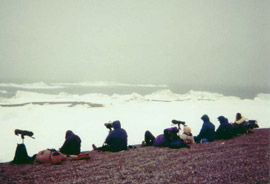 Looking for birds at Gambell, the St. Lawrence Island in the Bering Sea. (Photo: Greg Miller)
Looking for birds at Gambell, the St. Lawrence Island in the Bering Sea. (Photo: Greg Miller) 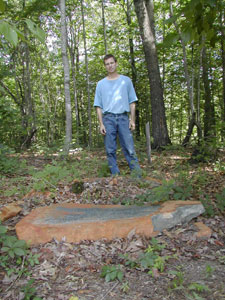 Dr. Billy Campbell (Photo: Mitzi Rapkin)
Dr. Billy Campbell (Photo: Mitzi Rapkin) 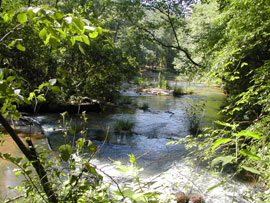
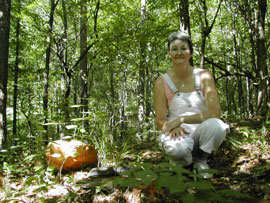 Bonnie Ramey (Photo: Mitzi Rapkin)
Bonnie Ramey (Photo: Mitzi Rapkin) 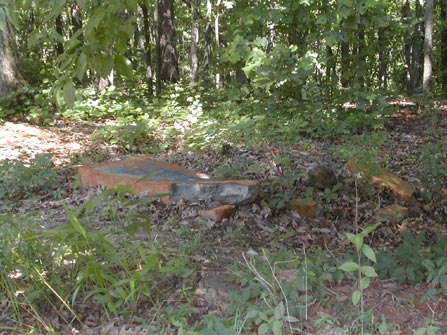 A gravesite at Ramsey Creek Preserve. (Photo: Mitzi Rapkin)
A gravesite at Ramsey Creek Preserve. (Photo: Mitzi Rapkin) 



